Over the past few years, more and more companies all around the world have been driven towards automation. According to McKinsey, the number of businesses that have fully automated at least one function have grown with a percentage of 31% in 2020. A function usually comprises multiple business processes, so this statistic indicates that the proclivity towards Business Process Automation (BPA) is growing steadily.
You must have heard the term Business Process Automation before, perhaps more and more in recent times. Usually, this term occurs in one breath with administrative or back office tasks that are inherent in many corporate business processes.
But what does BPA entail exactly? Well, if you’re looking for an all-encompassing explainer on BPA, you’ve come to the right place. In this ultimate guide, we’ll define BPA, what its trends are for 2021, how implementing BPA can benefit your business, and more!
So let’s start off with the definition of BPA.
What is BPA?
Business process automation (BPA) is letting technology take repetitive yet necessary tasks out of your hands. In the bare basics, this would mean that you can have a task, or business process, completed without your involvement. Automation software applied in the workflow these days often uses machine learning and artificial intelligence (AI) so that no human brains or hands are required to complete specific tasks.
The average business process usually involves a workflow consisting of tasks that require an employee to perform menial tasks by hand, like entering data into a system to claim expenses, creating overviews in spreadsheets, or validating a customer’s identity in an onboarding process. These are mere examples, as BPA can take many forms for many specific businesses industry-wide.
The primary aim of BPA is to refocus employee attention from mundane and administrative work to the high-valued projects that they were hired for in the first place. So your employees’ intrinsic skill sets are brought to bear on tasks that they are actually required for.
There is an extended market serving BPA needs, each provider with their own specialties for certain tasks or industries.
A short history of BPA
As humans, we are prone to automating tasks for as long as we’ve been present on this planet. We can always look at the Ancient Greeks or, for instance, Charles Babbage and his invention of the steam-powered calculator in the 1800s as some of the first forms of automation. But for an exact history of Business Process Automation, it is more useful to start with the emergence of material requirements planning (MRP) systems as a predecessor of enterprise resource planning (ERP) systems.
The MRP system was first applied in the 1960s and automated the purchase planning of required materials in the logistics sector. This form of automated planning was extended to more industries in the 1970s and gained new qualities in the 1980s. In the following decade, ERP systems emerged, mostly in the form of software that supported business processes in the form of providing digital databases.
In the 2000s, automation evolved in the form of machine learning and artificial intelligence (AI), leading to the term ‘automation’ gaining a new dimension. Data that normally could only be processed by a human, could now be taught to an AI so that business processes could increasingly be extended to computers. At present, we are experiencing the emergence of robotic process automation (RPA), which allows automation via a user interface. This simplifies the use of automation for more and more businesses across a wider spectrum of industries. All of these systems are encompassed under the larger umbrella which is business process automation.
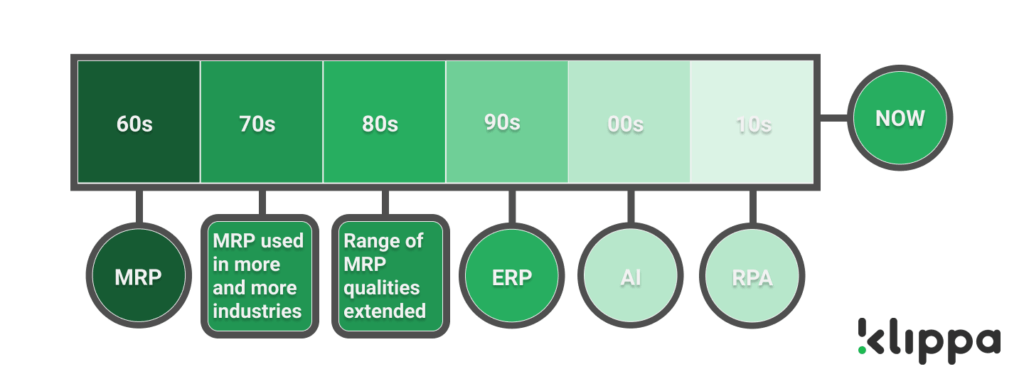

BPA, BPO, BPM and RPA
The lingo of the different business processing solutions can be confusing, as in essence they are all connected or part of one another. So let’s tackle them by looking at them in a short but sweet overview.
| Business Process Automation (BPA) is the core of our present ultimate guide. It involves anything aimed at performing tasks and completing processes through automation and thus improving a business workflow. Usually, BPA entails a form of software that is implemented for either a specific process or an entire workflow. It is aimed at improving speed, accuracy, and cost efficiency. |
| Business Process Outsourcing (BPO) is having menial and repetitive tasks in the workflow, data entry, for example, performed by an external agency in a low-wage country. Although you could also label extending these tasks to an AI by outsourcing them to a computer, BPO is generally meant to involve an off-shore outsourcing company. A huge factor in choosing either BPO or BPA is cost and effectiveness. It’s important to realize that opting for BPA will save you 60% of the costs you would normally spend on BPO. |
| Business Process Management (BPM) is an umbrella term for the strategy businesses apply to improve specific processes in their workflows. In essence, it is looking at your processing capabilities through the lens of efficiency improvement and cost reduction. In a way, BPA, BPO, and RPA are tactics aimed at using tools for this purpose, whilst BPM is aimed at providing an overview of your process optimization. |
| Robotic Process Automation (RPA) is another method of automating day-to-day tasks, but specifically focuses on state-of-the-art technology in machine learning and AI, or simply termed: robotics. In a way, it is part of BPA, but it has an inherently technological focus on automation. As mentioned before, this method will be increasingly standardized to propel businesses into a sustainable future. In fact, at Klippa we also provide RPA building blocks that can easily be integrated into well-known RPA platforms such as Automation Anywhere, UiPath and Mendix. |
These terms are often mentioned in one breath with each other, so it’s important to be aware of the distinctions between the terms.


What are the latest BPA trends?
The advancement of BPA solutions is never at a standstill and keeps improving to cope with developments in the world today. As we’ve seen over its history, BPA is adapted to what businesses require to speed up, simplify, and make their processing more efficient. So let’s take a look at the latest trends around BPA in 2021.
Increasing growth due to COVID-19
The still present global pandemic is causing more businesses to transform into a fully digital workplace. We now have what we can safely call ‘digital employees’, who complete most, if not all, their work on a screen. Business executives who already considered digital transformation before, have now seen the need to accelerate the process. An executive survey performed by McKinsey indicates that the acceleration of digitization and automation at 67% of all companies is propelled by the COVID-19 pandemic.
As we’re not quite sure yet what the world will look like after things settle down again, businesses around the globe are looking at all options to boost the technological progress of replacing menial tasks now performed by employees and extending them to AI. Over time, this will lead to hybrid companies, where work is partly done by BPA software and governed by humans.
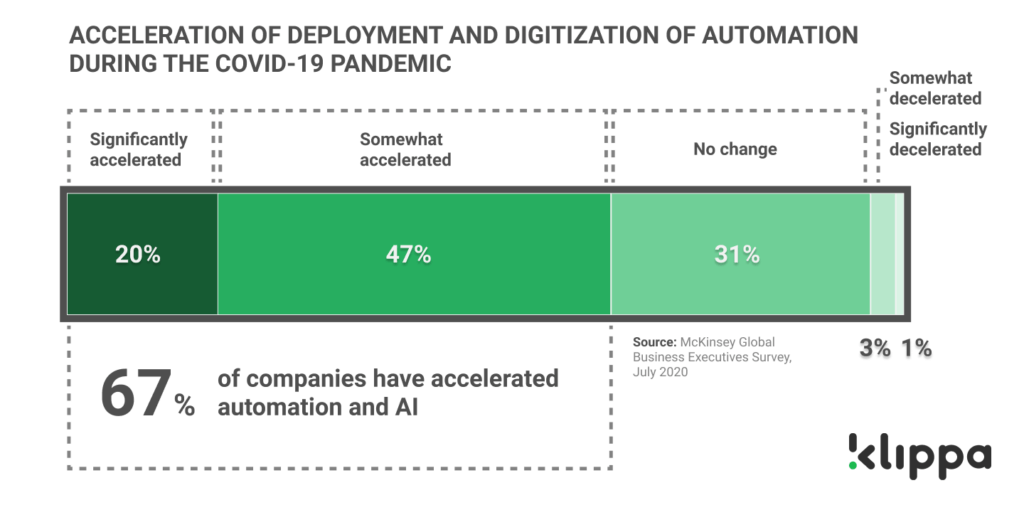

Hyperautomation
The pandemic has motivated leading businesses to combine any means possible to improve their workflow automation by joining all forces currently at play in BPA. Hyperautomation is a streamlined combination of intelligent business process management (IBPM), machine learning, AI, and RPA that allows companies to further improve supply automated workflows and process information with hyper-speed.
This trend generally occurs because businesses aim to refocus employee attention away from any menial tasks that can be performed by AI. This way, employees can invest their skills in more high-value tasks.
BPA for cybersecurity
As Voltaire once said: “With great power comes great responsibility.” Improving your automated business workflows by deploying software and AI also asks for increased security requirements. Automation not only emerges in business process improvement but also cybercrime. In recent times, CEO fraud, and mass automated phishing attacks, aimed at stealing personal data, are increasingly grabbing headlines in tech news platforms.
When used correctly, automation can also aid in the security of privacy-sensitive data processing, by setting up checks and inducing red flags recognized by an extensively trained AI. Identifying fake logins or information requests via an automatism supported by AI can be done more efficiently in case of a mass cyberattack.
RPA as a standard
Although RPA isn’t exactly new, the industry is growing exponentially. Grand View Research indicates that the projected growth of the RPA market will reach $25.56 billion by 2027. As such, it will become a standard in modern business processing. Companies in any industry will look to invest in RPA before considering hiring employees for certain tasks.
At present, sophisticated algorithms are able to perform increasing types of data analyses formerly executed by human employees. This is not to say that robots will replace all humans in the work, but simply increasingly refocuse the activities of human employees to other, high-end functions. Not only does this speed up and improve the accuracy of business processes, but also makes them more sustainable moving forward.


What are the benefits of BPA?
Implementing BPA into your everyday workflows has numerous advantages that might not have crossed your mind before. So let’s have a look at what benefits your business could experience at face value when you start implementing BPA:
Cost reduction
Automation via software often causes you to save on employee FTEs for specific tasks, not only in terms of salary but also in office rental sum and other related costs. You get more efficiency for less money. This cost reduction can run from 40% up to 75% and your investment will be earned back in a matter of years or even months.
Improves speed and efficiency
As can be reasonably assumed, computers do not tire of a 24/7 working week and can perform multiple tasks at once. This allows for faster workflows with a better-streamlined focus on menial work.
Prevents errors
Efficiency is also gained by having to spend less time correcting human error in, for instance, a data entry process. Humans are more prone to mistype or overlook certain statistics or figures that are crucial in a business process. With the help of data extraction through OCR, you can be sure that typos, missing info, or any other human error are a thing of the past.
Increases employee satisfaction
Those tedious tasks that often take up more time for employees are eliminated from their work week, allowing them to focus on what is important for both themselves and the company. This sense of importance leads to better overall happiness in their work.
Improves compliance
Setting up automated workflows also simplifies the adherence to compliance requirements. Think of adding automated checks and processes to adhere to GDPR requirements or simply making your documents GDPR compliant.
Simplifies business processes
As all subtasks involved in an automated process are overseen by an AI, employees can consider an entire business process as one performed task rather than a series of different tasks.
Futureproof
You can safely assume that technology will continue to improve over time, and with that, the BPA solutions will only be able to take over more and more processes with increased speed and efficiency.
24/7 customer service
When your company competes in a global market, you will encounter problems with global time differences, if you don’t have offices set up around the world. When you apply BPA in the form of chatbots and other forms of automation, you can easily provide service at any time of day from one single office. According to a study performed by Capgemini, “63% of AI-aware consumers like AI because of its 24/7 availability and how it provides greater control over their interactions.” So customer satisfaction will certainly increase as a result.
These are the benefits up front, but if you are wondering what benefits early adopters of BPA technology have experienced then you might consider a study performed by Deloitte. Respondents indicated the following occurrences:
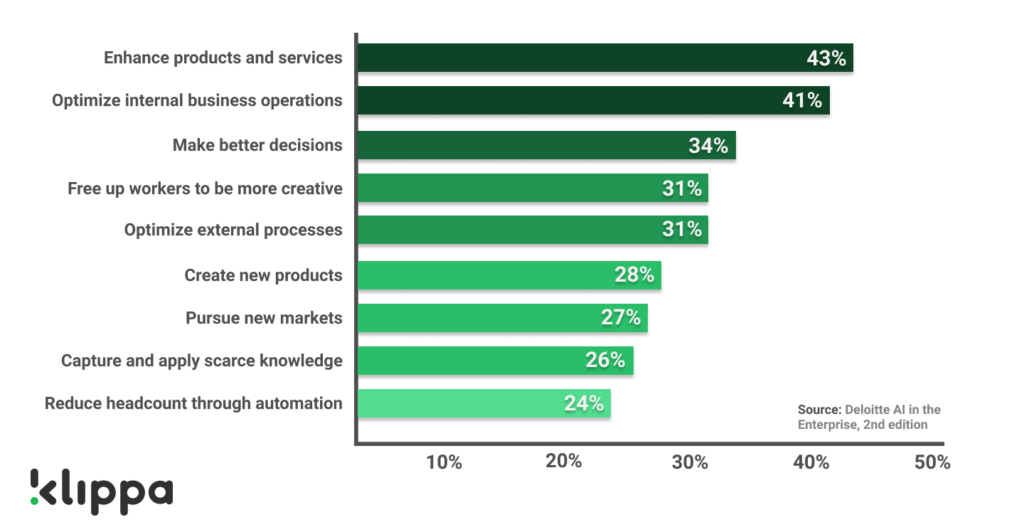

In most cases, such benefits aren’t the primary reasons for adopting BPA. What’s more, you may think that these benefits only work for a couple of specific businesses, but they work for businesses from many different industries. So let’s take a look at some use cases and examples of BPA in practice.
Use cases and practical examples of applied BPA
BPA can serve businesses in any industry, as there are use cases that are universal across the many different layers of business processing. So if you need to know whether BPA can be a solution for you and your company, consider the following use cases concerning your own business processes:
Expense management
Given the extensive possibilities about replacing paper streams with automated digital data exchange, it is quite surprising to see that many companies still perform expense management manually: An employee reports an expense by manually copying data from a receipt into either a printed or a software form and adds a scan or photo of the receipt to the report. It then goes to the finance department where the request is processed and sent to the one responsible for authorizing and back again for processing. Usually, a colleague at the finance department adds expenses to overview spreadsheets as well. The employee then receives the refund after about two weeks to a month.
Nearly all of the steps in this process can be automated and therefore performed quicker and more accurately. Ideally, an employee would only need to make a picture of the expense with their smartphone, after which all data is extracted automatically and sent over to the authorizing party. The authorizer receives a notification on their smartphone when there is a new expense to approve, simply authorize it with a press of a button, and off you go! The employee would only need to send in a picture of the receipt, from which automatically extracted data is sent to the authorizing party and added to an overview within a matter of seconds. If you are looking for such an automated expense management solution, Klippa has precisely this service to offer.
And if your company has only partly extended this process to BPA, it is even possible to fully customize each step in the expense process according to your specific needs.
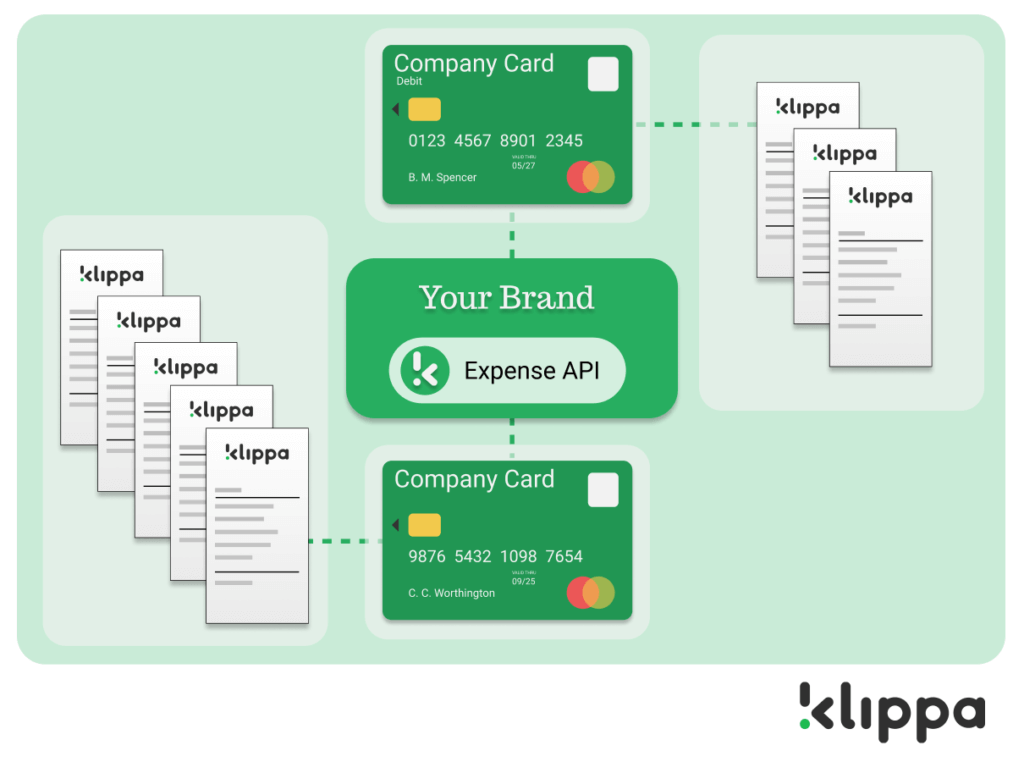

Accounts payable solutions
Some companies have to process hundreds to even thousands of invoices each month. The incoming invoices are often organized and checked by human eyes, after which they are sent to those who need to authorize payment of the required sum. Every single invoice needs to be categorized so that it is sent to the correct person to authorize later. In the meantime, these invoices are all individually checked for errors or incoherencies. Then someone needs to make sure that they are authorized within the due date of the invoice. Once that is complete, the payment can be made, added to the financial overview and filed. Phew. That’s a long day’s work.
Deploying OCR and AI technologies, this process can be streamlined with BPA. Any specific task involved in the process can be outlined in an automated task loop that automatically reads incoming invoices, categorizes them and sends them to the correct person for authorization. The invoice is then automatically added to an overview in your online database and a payment request is automatically sent to the finance department. A lot of invoices can be processed simultaneously and flawlessly. Have a look at our blog about the ROI calculation of accounts payable automation if you would like to know more.
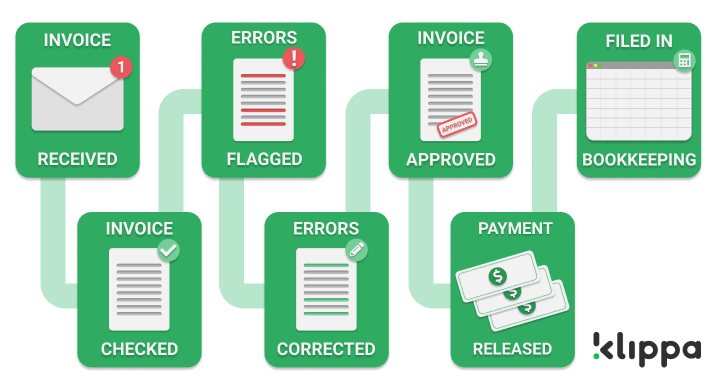

Customer onboarding processes
Conforming to privacy- and KYC regulations can be quite an exhaustive process for companies. Customers trust companies with their personal details when applying for a specific service. For instance, when you think of opening a bank account, the bank requires a photo of your ID to ensure that the bank account is linked to an actual person. To verify the photo, usually, a bank clerk needs to check and validate all the information on the card with a database and make sure that the photo is not manipulated in any way. Errors made in this process can have serious consequences for both the bank and the customer.
That’s why BPA in this scenario is an important safety measure. With machine learning, a trained AI can identify irregularities and incoherent pixel patterns that the human eye would easily miss. The information on the ID card can be automatically extracted and checked next to an existing database for verification. This can even apply to extracting the signature on an ID card. The safety of automation eliminates human error and reduces fraud, which allows banks and other companies to conform to GDPR- and other privacy-related regulations.
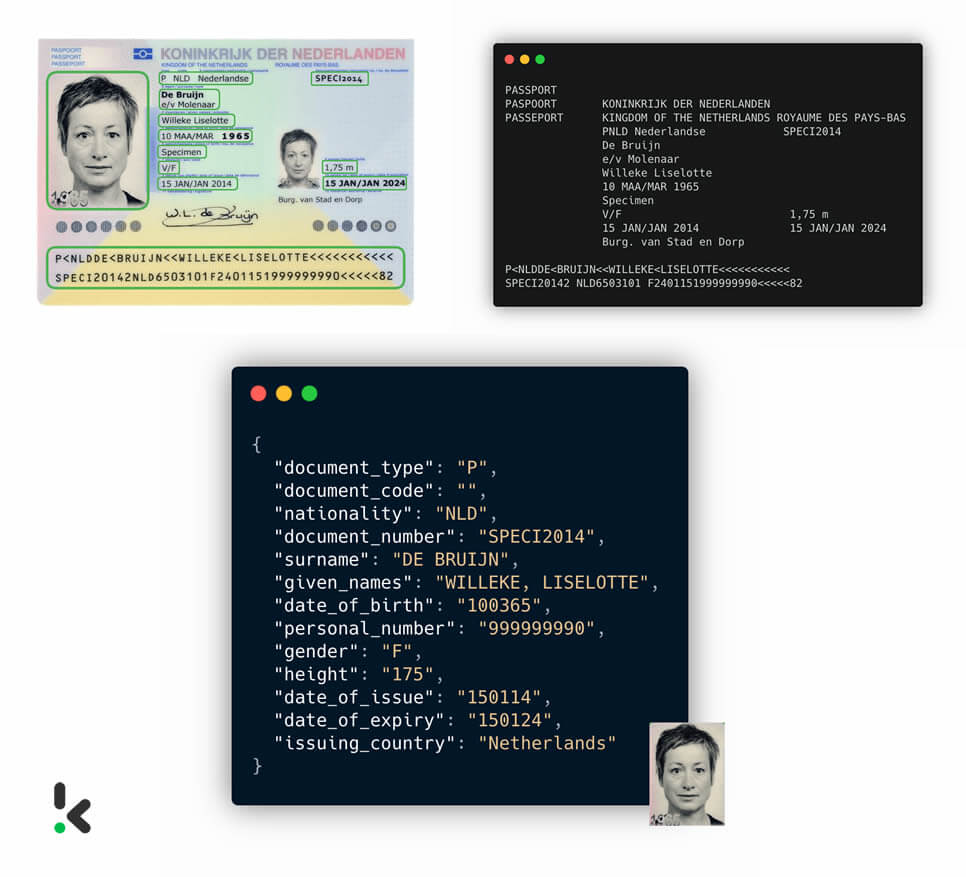

As ever, these are but a few of the numerous applications for BPA in practice. You can think of collecting mass data on supermarket receipts or menu cards, or of automating your cashback– and loyalty campaigns. So if this has interested you in finding out how BPA can work for your company, perhaps it would help to read about the steps you can take to get started with the implementation of BPA.
Getting started with BPA
Just to help you get started with your tentative exploration of BPA for your business, here are some steps you can take to ensure your colleagues that you’re doing the right thing. The steps to take in your business case are:
- Define a mission statement
Make sure you know what both your short- and long-term goals are when determining what form of BPA to apply. What is your primary goal? Speed up a process? Reducing costs in a process? It is important to have this clear in your mind before you delve into research and solutions. - Research
Take a look at the current business processes within your company, or even within your team. Take note of every repetitive task within an overarching process and determine where possible errors might occur. Are there ways to streamline a process by reducing human involvement? The focus of your research should be in line with your mission statement. - Explore the BPA market
As BPA has been around for a while, there is a booming market full of providers aiming to help you out. Each of these tools has its own individual pros and cons and is often aimed at specific industries or tasks. Map out the options that may fit your company best, by looking at the specifics of the offered service. When you like a company, such as Klippa, it is always good to enter a tentative conversation with them to gain more accurate information. - Calculate the ROI of the solution
Once you have sifted through the list of providers and narrowed down the contenders to a short list of two or three, it’s time to calculate what it is you would save in terms of financial investment. Have a look at our example calculation for automated accounts payable solutions if you need an example of such a calculation. - Test and evaluate the chosen solution
Probably, your ROI calculation will have enabled you to choose your ideal contender and start by contacting that provider to start using their solution. It is important that the provider can serve your needs, so make sure there is a way you can test and evaluate the chosen solution. This can involve asking for feedback from your colleagues and keeping the provider in the loop for improvements. - Keep track of solutions
Once you’ve chosen your provider and have been using their BPA service for a while, it is still good to regularly identify other automation opportunities or improvements. This allows you to always be up to par with innovations in the automation industry.
Finding the right provider might take some time, but it is important to make sure you have the right solution. In the end, BPA will need to save you time and money, rather than taking up a lot of your attention that is better spent elsewhere.
BPA at Klippa
As it happens, you are reading this blog on the website of a provider who offers multiple opportunities in the field of BPA. Klippa can help you with all of the cases mentioned above and more. So feel free to shoot an email to [email protected] or schedule an online demo below.